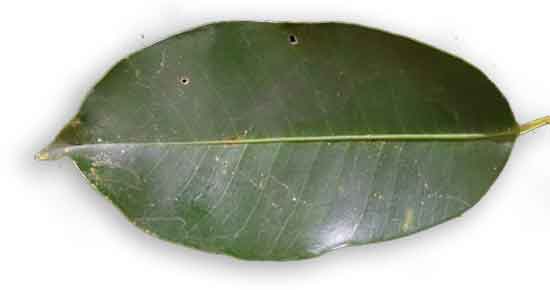 Gen info Gen info
- Gutta-perch, a hard tough thermoplastic substance, is a coagulated latex obtained from certain Malaysian trees. It consists chiefly of a hydrocarbon isomeric with rubber, used chiefly in dentistry and electrical insulation. The gutta-percha from P. leeri is of good quality and used similarly to Palaquim gutta. It has been used extensively for submarine and underground cables due to non-conductivity for electricity and heat, and its imperviousness to water. Gutta-percha is malleable; it can be moulded into any shape, like pistol grips, decorative furniture, jewelry, and suchlike. Golf balls used to be made with an outer cover of gutta-percha. It has been used for medical and chemical instruments, in dental clinics, transmission belts, as adhesives and waterproofing agent, and as ingredient in chewing gum.
- The latex of P. leeri contains less debris and is whiter than the 'getah merah' from Palaquium gutta. becoming yellow when exposed. (2)
- Yield of gutta-percha of P. leeri is generally low: 60-270 g can be obtained from felled trees of 17-26 cm diameter. Tapping trials yielded only 3-22 g/tree. (2)
- Gutta percha from P. leeri is not an important commodity; but rather, as a timber-yielding tree.
Botany
• A medium-sized to fairly large tree up to 40 m tall, with columnar bole up to 80 cm in diameter, buttressed, containing white latex which turns yellow upon exposure; twigs slender and terete, usually hairy or scurfy. Leaves alternate or arranged spirally, simple, entire; stipules 3-4 mm long, falling off early; petiole 0.5-1.5 cm long; blade broadly ovate to oblong-lanceolate, 5-16 cm x 1.5-8 cm, base cuneate to rounded, apex acuminate, glabrous on both sides; midrib sunken above and prominent below, secondary veins 11-18, straight, curving towards apex and joined near leaf margin, tertiary veins mostly descending from marginal conjunctions of secondary veins and ramifying into 2-3 branches which run parallel towards the midrib, tertiary vein just visible on lower leaf surface. Inflorescence a small, axillary (sometimes pseudo-terminal) fascicle, 1-8-flowered, often in defoliate leaf-axils; pedicel 1-1.5 cm long; flowers bisexual, very small, up to 0.5 cm long, white to yellow-white; sepals 4, 2-4 mm long, 2 outer ones thick and fleshy, 2 inner ones thinner; corolla 8-lobed, 2 mm long, with short tube, glabrous, white or yellowish-white; stamens 16, inserted at the throat of the corolla tube, with short, pubescent filaments, acute anthers and long-ciliated connective; pistil 1, with long conoidal 8-celled ovary and persistent style, 6-8 mm long. Fruit a berry, cone-shaped or narrowly so, with a flat broad base, 2.5-5 cm x 1-2.5 cm, glabrous or subglabrous, abruptly passing into the style at apex, usually 1-seeded, green. Seedling with epigeal germination, hypocotyl elongated; cotyledons emergent; leaves alternate-spiral from the start. (2)
 Distribution Distribution
- Native to the Philippines.
- In Mindanao, Davao, Zamboanga, and Zamboanga del Sur; Palawan, Tawi-tawi.
- Also native to Borneo, Malaya, Myanmar,
Sumatera . (1)
- Found in coastal lowland forests from sea level to 650 m altitude.
- In 2013, classified as "Near Threatened" in the IUCN Red List of Threatened Species.
- Projected continued population decline
from destructive collection of latex.
Constituents
- Plant yields good quality gutta -percha.
-
Raw gutta-percha from Payena spp, probably mainly P. leerii, contains 14-26% water, 40-46% gutta, 30-32% resin and 3-8% foreign material; when purified, it contains 54% gutta and 46% resin. Some trees yield a sticky gutta-percha; some, a non-sticky gutta-percha. (2)
Properties
Properties
Parts used
Bark, latex.
Uses
Edibility
- Fruits is edible and sweet; eaten raw.
Folkloric
- In India, bark extract used for snake bites. (3)
Others
- Wood: Heavy with density of 760-1060 kg/m3 at 15% moisture content. Heartwood is deep pink, red, red-brown or purple brown, sometimes with dark streaks. (2) Wood belongs to a group of timbers collectively called "Bitis". (4)
- Oil: Seed yields 3.5-4.5% oil. (2)
- Construction: Suitable for all forms of heavy construction, bridges, wharves, piers, piling, posts, railway sleepers, parquet flooring.
- Dentistry: Still used in dentistry; its bio-inertness makes it ideal for use as temporary filling for teeth or filling material inside tooth fillings. (4)
Studies
• No studies found.
Availability
Wild-crafted.
|

![]()



 Gen info
Gen info
